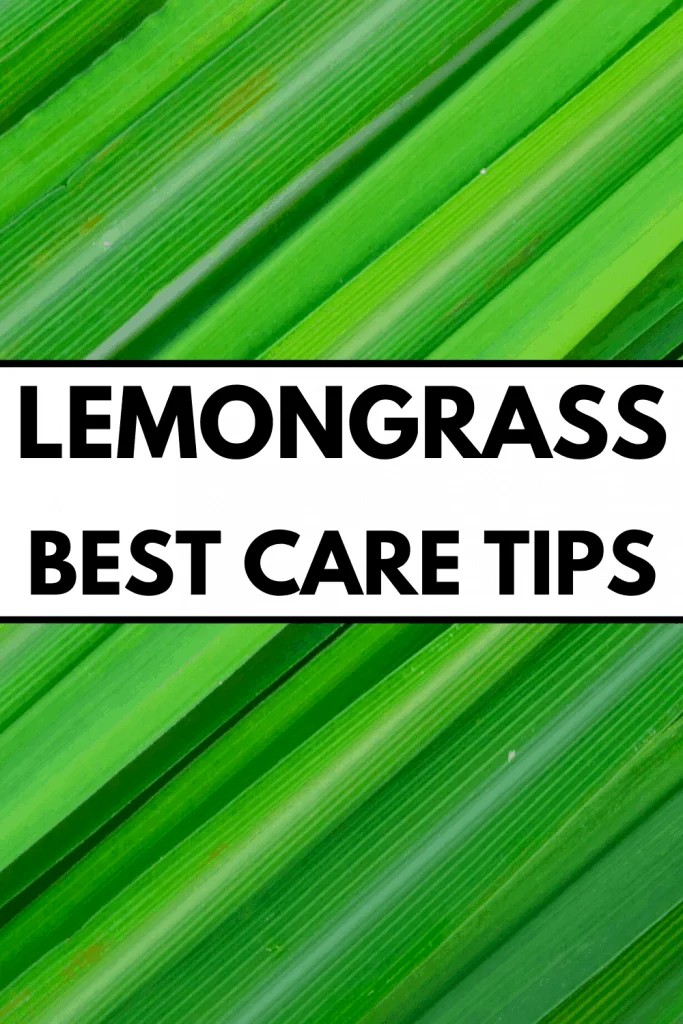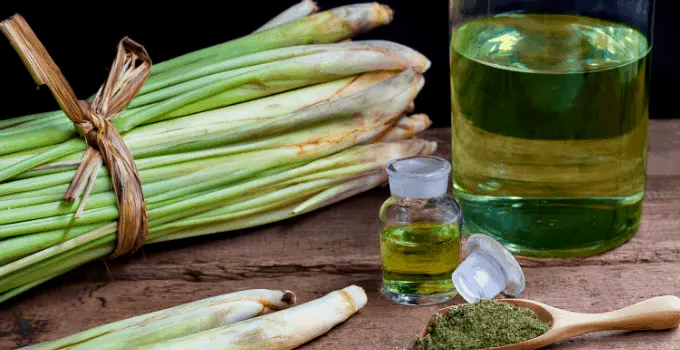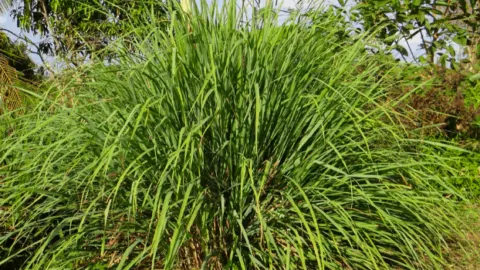Lemongrass indoor and outdoor care. Have you ever considered growing grass inside your home?
Lemongrass, or Cymbopogon citratus, is an herb that can be used for many reasons.
I started planting lemongrass just in the garden. It took me some time to realize that I could also grow this plant as a houseplant. Given the many benefits, a great choice of mine 😉
Besides being used for Asian dishes and meals, this plant eases issues with the digestive system, low-grade fevers, high blood pressure, and achy joints. Growing it indoors is easy!
As expected, this herb is found in the family Poaceae, or grasses and sedges. The Lemongrass plant can be found naturally in the tropical grasslands of South Asia and Australia.
They are known for their citrus-scented leaves that grow in thick clumps. This article will focus on how to keep your Lemongrass happy so that you can use it however you see fit!
Table of Contents
Lemon Grass Care
To care for lemongrass provide, a temperature between 59-70 degrees Fahrenheit is ideal (15-21 degrees Celsius). Choose organic matter such as compost, leaf mold, and manure for soil. Bright direct sunlight is best. Water often before the top inch of soil gets dry (2.5cm). Fertilize monthly in spring and summer with a fertilizer high in nitrogen.

Lemon Grass Growing guide
These members of Poaceae are quick to grow as long as you can copy their natural habitat. By ensuring they get all the essentials, you’ll have a fragrant flora that you can use in some recipes!
Soil
Cymbopogon citratus needs quite a few nutrients to grow properly. Giving it plenty of organic matter such as compost, leaf mold, and manure is a great way to supply them with everything they need.
This is especially true if you raise it in a pot instead of the garden. Loamy soil also works wonders! The soil should also be able to drain properly.
Lemongrass typically does best when placed in soil that is fairly neutral, somewhere between 6.8 and 7.2 for the pH.
Light
Put the plant in a spot with bright direct light. A south-facing window or a south-facing spot in your garden is best.
Placing them on a windowsill to receive full, direct sunlight is the perfect spot. Plants that grow at a quicker rate, such as grasses, tend to need more light.
You’ll want to keep them in a spot with plenty of sunshine, even in the winter. The stalks of a Lemongrass plant quickly shift to a brown hue when not given adequate food in chlorophyll.
Watering
Water whenever the soil is about to dry out.
You can give it as much water as you like, so long as the soil does not become muddy. Drying out roots is far more hazardous than adding too much moisture to your Lemongrass.
If you want a healthy herb, consider watering daily during the warmer months outside.
Temperature
The ideal temperature is 59-70 degrees Fahrenheit (15-21 degrees Celsius).
We’ve discussed how much light these plants need to be happy. Well, the same goes for overall warmth. In their natural habitat, Cymbopogon citratus experiences hot periods during the growing season.
Trying to replicate this within your home would keep it fragrant and lively. Anything below 39 degrees Fahrenheit (4 degrees Celsius) results in stunted or halted growth.
Ideally, you should keep your Lemongrass plant in a spot that is much warmer than this, especially during the growing seasons.
Humidity
The ideal humidity is 60-80%
If you’ve ever visited the southeastern regions of Asia, you may have noticed how humid it was. Most of the plants in those areas need plenty of water, either through rainfall or moisture trapped in the air.
Don’t let this concern you too much. The average household should have enough humidity for a Lemongrass plant. Just be mindful of the different areas that can be too dry for your herb.
Such areas include near an open window or a heating vent. You can also increase the humidity through routine misting if you’re unsure about the dryness of your home.
Fertilizer
Fertilize monthly in spring and summer. Or add slow-release fertilizer every 4-6 months.
Plants that grow rapidly generally need to be supplied with many nutrients. The most important nutrient for Lemongrass is nitrogen.
Lemongrass has a dormant period that lasts through the fall and winter.
Lemongrass doesn’t require plant food during this time. If you’re still unsure about the nutrients found in soil, read our article on Fertilization 101!
Propagation
Propagating your Lemongrass plant is a great way to grow your delectable herb without going to the store. Due to an extremely quick growth rate, Cymbopogon citratus is easy to copy from the parent plant.
The easiest way to go about doing this is by division. Lemongrass can also be propagated through the use of stem cuttings. You can even buy these at the store.
These plants are known for their high success rate in terms of rooting. We will have a section later on that is dedicated to the detailed steps involving division.
Growth
Grasses aren’t particularly known for their overall size.
Potting
It may take a while, but Citronella plants can grow quite leggy. When left unattended for too long, blooms will diminish. Pruning is one way that you can keep these individuals healthy.
Another technique is transplanting or repotting. This will stop the roots from growing out to be too long, thus affecting the plant’s overall health.
For Lemongrass plants, you’ll need to transfer them to a different pot once every few years. Fortunately, these small perennials don’t need to be repotted due to their size and slow growth rate.
Citronella Watering
Providing water for your Citronella plant is not all that tricky as long as you remember that they prefer to be on the drier side of the spectrum.
This does not mean that they like to be dried out, however. They still need a fair amount of moisture to survive. Overall, plant enthusiasts agree that Lemongrass plants like to have about 30 inches of water annually.
The general rule for finding the right schedule is to check the soil directly. Stick your finger into the top two inches of soil.
If it is dry, you should water enough to fully saturate the soil to the roots. On average, you can expect to water your Citronella plant once every few days.
Propagation
Lemongrass plants belong to the Geranium (Geraniaceae) family. These plants are best propagated through cuttings.
Propagation through division often fails as roots rot. Here
Stem cutting propagation
- Start by finding the plant you want to copy, preferably one without dead foliage that smells quite fresh.
- Take sharp scissors and make incisions on a stem just below the node. These cuts should be about four to six inches in length.
- Any leaves located towards the stem’s end should be carefully stripped.
- Place the stem cuttings, with the open side down, into a pot with fresh soil.
- Water the new individual thoroughly and set it in a bright, indirect sunlight spot.
- Check on the new individuals, watering whenever the soil feels dry. This should take about a week or two. From there, transfer it to a larger pot.
Citronella Pest Problems
You may have heard Lemongrass plants get their name due to their repelling properties. Although somewhat successful in that regard, they do not fully deter Lemongrasses from invading your home.
But do these individuals have pests of their own?
As far as being under attack by bugs, these Geraniums don’t have to worry. They do a pretty good job of keeping beetles, squash bugs, hornworms, aphids, and whiteflies at bay.
What they have to worry about most are diseases.
Leaf blight is the most deadly disease that you could find in your Lemongrass plant.
The best way to tackle such a problem is to use specifically designed fungicides. If you catch it early enough, it won’t take many treatments.

Sad Lemongrass – Problems with Your Plant that are Pest and Disease related
The Lemongrass plant, as a whole, is relatively hardy. That, however, does not make them immune to certain problems and issues. Knowing what to look for can save your plant from serious harm later.
Problem #1: LEAVES DROOPING
Leaves that look a bit sad and tend to droop are a clear indicator that your Geranium is experiencing soil that is dried out.
To fix the drooping of the plant’s foliage, attempt to alter your watering schedule. We suggest that you do this in increments, as Citronella can be sensitive to too much water.
Problem #2: YELLOW FOLIAGE
If you notice yellowing of the leaves, you should assume that your Lemongrass plant is battling with overwatering.
The best solution is to let your plant dry out, followed by an adjusted watering schedule. It might take a while to find the right routine.
Problem #3: BLACK SPOTS
Black spots on the leaves usually occur in combination with the browning of lower leaves. These are hints that your plant is grappling with too much sun exposure.
Remember that these floras prefer bright, indirect sunlight. Moving your plant to a spot with less sun is usually better.
Problem #4: CURLING LEAVES
White spots and the curling of the leaves can be a sign that you may not be providing enough sunlight for your Citronella.
Find a spot in your house with plenty of sunshine, preferably near a large window. Even full sunlight for six to eight hours daily is fine for these individuals.
Frequently Asked Questions
Do Lemongrass plants work to deter bugs from invading your home?
As a whole, these floras do work to help deter bugs from invading your home. Citronella emits a smell that is unappealing for such bugs. There are, however, other plants that have a higher success rate.
Does Citronella grow back every year?
Being a perennial, Citronella does come back annually. In some areas of the world, it is grown annually, so just be sure to research.
How do you prune a Lemongrass plant?
Pruning is a great way to stop your Citronella from becoming too leggy. To do so, you can pinch back the stems once they reach anywhere longer than four inches in length. You’ll want to pinch above the leaf to remove any stems. There should be at least three leaves per stem for a healthy plant.
Is Lemongrass poisonous to cats & dogs?
Lemongrass is poisonous to both cats & dogs. Therefore, keep this plant away from your pets.
5 Lemon Grass Care Takeaways
Best five tips for Lemon grass care:
- Provide lots of direct sunlight
- Do not overwater. Ensure the plant is not getting too much moisture so the roots will become waterlogged
- A temperature between 59-70 degrees Fahrenheit is ideal (15-21 degrees Celsius)
- Keep the humidity relatively high through the use of humidifiers and misters
- Look out for signs of blight so that you can tackle it with fungicides early on

Daniel has been a plant enthusiast for over 20 years. He owns hundreds of houseplants and prepares for the chili growing seasons yearly with great anticipation. His favorite plants are plant species in the Araceae family, such as Monstera, Philodendron, and Anthurium. He also loves gardening and is growing hot peppers, tomatoes, and many more vegetables.


